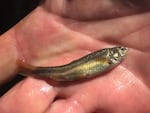
Foskett Spring in Lake County, Ore., is home to the Foskett speckled dace, a minnow recently removed from the endangered species list.
Larisa Bogardus/BLM
UPDATE (Sept. 12, 3:29 p.m. PT) — The U.S. Fish and Wildlife Service is removing a southeast Oregon fish from the endangered species list.
The Foskett speckled dace — a 4-inch, greenish-gray minnow — is the third Oregon fish to be declared recovered. It's a move that eliminates special protections evoked under the Endangered Species Act. A fourth Oregon fish species, the Borax Lake chub is currently proposed for delisting.
“The Service is thrilled with Oregon’s progress,” said Pacific region director Robyn Thorson in a press release. “We can now direct our focus to species that are more in need of recovery efforts.”
The Foskett speckled dace is native to tiny Foskett Spring about 30 miles east of Lakeview. The fish were initially listed as threatened in 1985 under the Endangered Species Act. Foskett Spring was on private property and cattle grazing had damaged the fish’s spring and wetland habitat to the point where survival of the minnow was in question.
“Some of the initial observations made during the 1970s, when concern for the fish was first raised, people observed fish swimming in the cattle hoof prints in the mud,” government biologist Alan Mauer said.
Since the fish became federally protected, the Bureau of Land Management purchased the land around the spring and built a fence to keep out cattle.
Then wildlife managers were faced with another problem: the cattails, bulrushes and other vegetation grew in so thick that it started to take over open water habitat that the dace prefers.
“I don’t want to say we overprotected it, but it’s kind of like the pendulum swung the other direction,” Mauer said.

The Foskett speckled dace, a minnow native to Foskett Spring in Lake County, Ore., was recently removed from the endangered species list.
U.S. Fish and Wildlife Service
So now, federal agencies periodically dig out or burn areas of thick vegetation to open up the habitat. Mauer said this work likely corresponds to major surges in Foskett speckled dace numbers.
Since listing, the number of dace has swung between 750 and 25,000 fish — but 4,000-10,000 fish is the more typical population.
In the case of the Foskett speckled dace, conservation work by federal agencies won’t stop with the fish's removal from the endangered species list. The Fish and Wildlife Service has an agreement with the Bureau of Land Management and Oregon Department of Fish and Wildlife to continue to monitor and do habitat work at the site.
“We have a long-term plan to occasionally — we hope it’s not constant, we hope it’s more just an occasional visit to the spring to assess whether we need to help the fish by opening up some of the habitat,” Mauer said. “We’re just trying to do this for the long-term persistence of the species.”
Government officials were celebrating the Endangered Species Act success story at the same time the Trump administration is proposing to weaken endangered species protections to benefit industries like mining, drilling, ranching and logging.
Noah Greenwald with the Center for Biological Diversity noted that the successful recovery of the Foskett speckled dace is being announced as the Trump administration "is working overtime to dismantle" the Endangered Species Act.
"It really proves the Endangered Species Act is working," Greenwald said. "The species would have certainly been lost without it."
